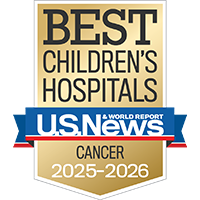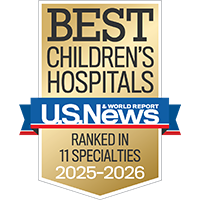Stress-free visits
Accommodations. Admissions. Procedure prep. Get the info you need for smoother hospital stays.
Prepare for your child's stay

Juvenile myelomonocytic leukemia (JMML) is a rare blood cancer that mainly affects young children. Most patients are diagnosed before they're 4 years old. JMML happens when immature monocytes (a type of white blood cell) multiply out of control.
As the abnormal monocytes multiply, they build up in the bone marrow (the spongy tissue inside bones), crowding out special cells there called hematopoietic stem cells. Hematopoietic stem cells can develop into any type of blood cell – red blood cells, white blood cells or platelets – so when they're displaced, it affects the body's ability to make healthy blood cells.
The abnormal cells can accumulate in other parts of the body as well, including the spleen, liver, lungs and skin.
JMML is much less common than other types of blood cancer, accounting for approximately 1 to 3% of all childhood leukemia cases. Boys are about twice as likely as girls to develop JMML.

Top 10 in the nation and best in Northern California for cancer care

Ranked among the nation's best in 11 specialties
Although the exact cause is unknown, research has shown that most children with JMML have an abnormality in a particular gene or chromosome.
Children with a genetic disorder called neurofibromatosis type 1 (NF1) have an elevated risk of developing JMML. Patients with a genetic condition called Noonan syndrome are at risk of developing a condition similar to JMML.
Patients with JMML may experience symptoms, such as:
When evaluating children for JMML, doctors perform a thorough physical exam and then may order the following tests:
To make the diagnosis, your child's doctor will need to rule out more common conditions that can cause the same signs and symptoms as JMML.
Currently, the main treatment – and only potential cure – for JMML is a type of bone marrow transplant called allogeneic hematopoietic stem cell transplantation. (Allogeneic means the stem cells come from someone other than the patient.)
In the days before the transplant procedure, the child receives high doses of chemotherapy. The goals for this phase of treatment are to kill the cancer cells, make room in the bone marrow for new stem cells to grow, and suppress the immune system so it won't attack the transplanted stem cells.
Next, the child receives an infusion of healthy hematopoietic stem cells from a genetically similar donor. The donor may be a relative or a stranger found through a bone marrow donor registry. The transplanted cells will travel to the child's bone marrow and begin the process of creating new blood cells.
About half of all patients with JMML go into long-term remission after the transplant, but the disease returns in about 30 to 40% of cases, often within a year. If the patient relapses, a second stem cell transplant is possible.
JMML patients with certain genetic mutations may not need a stem cell transplant. To find the right treatment for your child, we recommend working with a hematologist-oncologist (a doctor specializing in blood cancers) who is experienced in treating JMML.
At UCSF and other medical institutions, doctors are leading research to better understand JMML and find new and better treatments for it. This includes testing promising experimental therapies with human volunteers in clinical trials. If your family is interested in joining a clinical trial, please speak with your child's care team.
This information is for educational purposes only and is not intended to replace the advice of your child's doctor or other health care provider. We encourage you to discuss any questions or concerns you may have with your child's provider.
Stress-free visits
